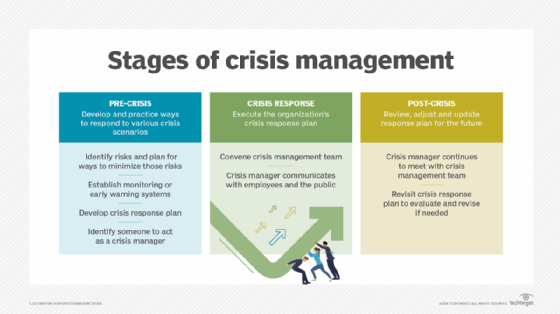
Navigating the Storm: Managing Employee Performance During a Crisis (A Beginner’s Guide)
Crises hit us like a sudden storm, shaking up our routines, our sense of security, and even our most basic ways of working. Whether it’s a global pandemic, an economic downturn, a natural disaster, or a major organizational change, these turbulent times present unique challenges for businesses and their employees.
As a manager, your role becomes even more critical during a crisis. It’s not just about keeping the ship afloat; it’s about guiding your team through choppy waters, ensuring their well-being, and helping them maintain productivity amidst uncertainty. Managing employee performance during a crisis isn’t about traditional performance reviews or strict deadlines; it’s about empathy, flexibility, clear communication, and unwavering support.
This comprehensive guide will walk you through the essential strategies for effectively managing employee performance when the world feels unpredictable. We’ll break down complex ideas into easy-to-understand steps, perfect for beginners looking to lead their teams with confidence and compassion.
Why Managing Performance During a Crisis is Different
In normal times, performance management often focuses on set goals, regular check-ins, and annual reviews. But a crisis changes everything. Here’s why traditional approaches might not work:
- Increased Stress & Anxiety: Employees are dealing with personal fears, family concerns, financial worries, and health anxieties. This directly impacts their focus, energy, and mental bandwidth.
- Blurred Lines Between Work & Life: Especially during remote work scenarios, the boundaries between professional and personal life can disappear, leading to burnout.
- Uncertainty & Lack of Control: When the future is unclear, it’s hard for anyone to plan or feel motivated. This can lead to procrastination or a feeling of helplessness.
- Changing Priorities: Business goals might shift rapidly, making previously set targets irrelevant or impossible to achieve.
- Resource Constraints: Access to tools, support systems, or even colleagues might be limited.
Because of these unique challenges, your approach to employee performance during a crisis needs to be more human-centered, adaptable, and supportive than ever before.
1. Prioritize Empathy and Well-being Above All Else
Before you even think about tasks or deadlines, remember that your employees are people, and they’re likely going through a lot. Your first priority should always be their well-being.
- Listen Actively:
- Don’t just hear, really listen: Ask open-ended questions like, "How are you really doing?" or "What’s the biggest challenge you’re facing right now?"
- Be Patient: Let them express their concerns without interruption. Sometimes, just having someone listen is a huge relief.
- Validate Feelings: Acknowledge their emotions. Say things like, "It sounds like you’re feeling a lot of pressure, and that’s completely understandable."
- Show Flexibility:
- Understand Personal Circumstances: Some employees might be juggling childcare, caring for sick family members, or dealing with unreliable internet.
- Adjust Schedules: If possible, allow for flexible working hours, compressed workweeks, or temporary changes in daily routines to accommodate personal needs.
- Focus on Outcomes, Not Hours: Emphasize what needs to be achieved rather than strictly monitoring login times.
- Promote Mental Health Resources:
- Share Information: Make sure employees know about any Employee Assistance Programs (EAPs), mental health hotlines, or company-provided counseling services.
- Encourage Breaks: Remind your team to take regular breaks, step away from screens, and disconnect at the end of the workday.
- Lead by Example: Share your own challenges (appropriately) and how you’re managing them to create a culture of openness.
2. Communicate Clearly, Consistently, and Compassionately
Uncertainty thrives in a vacuum. During a crisis, information is power, and clear communication is your strongest tool.
- Be Transparent (Within Reason):
- Share What You Know: Provide regular updates on the crisis’s impact on the company, even if it’s just to say, "We don’t have all the answers yet, but we’re working on it."
- Be Honest: Avoid sugarcoating difficult news. Employees appreciate honesty, even if the news is tough.
- Explain Decisions: When changes are made, explain the "why" behind them. This helps people understand and adapt.
- Set Clear Expectations:
- Define Priorities: With so much changing, help your team understand what the most critical tasks are. What absolutely must get done? What can wait?
- Outline New Processes: If work methods change (e.g., new remote tools, different approval processes), explain them clearly and patiently.
- Check for Understanding: Don’t assume everyone understood your message. Ask, "Does that make sense?" or "What questions do you have?"
- Maintain Regular Check-ins:
- Frequent, Shorter Meetings: Instead of one long weekly meeting, consider daily 15-minute stand-ups or brief one-on-one check-ins.
- Vary Communication Channels: Use video calls for face-to-face interaction, instant messaging for quick questions, and email for formal announcements.
- Create Safe Spaces: Encourage team members to share concerns or ask questions in a judgment-free environment.
3. Adapt Performance Expectations and Goals
Old goals might no longer make sense in a new reality. Your approach to managing employee performance during a crisis must include adapting what "success" looks like.
- Re-evaluate and Reprioritize Goals:
- Review Existing Goals: Go through each team member’s current goals. Are they still relevant? Are they achievable given the circumstances?
- Adjust or Pause Goals: Don’t be afraid to adjust targets, reduce scope, or even temporarily pause certain initiatives.
- Set New, Realistic Goals: Focus on short-term, achievable goals that align with the company’s immediate needs during the crisis. Break larger projects into smaller, manageable chunks.
- Focus on Key Deliverables (Outcomes):
- Shift from Activity to Impact: Instead of measuring hours worked or busywork, focus on the actual results and contributions. What value is being created?
- Identify "Must-Dos" vs. "Nice-to-Haves": Help your team narrow their focus to the most impactful tasks.
- Emphasize Quality Over Quantity:
- Reduce Pressure: Acknowledge that productivity might naturally dip. Prioritize quality work over trying to maintain pre-crisis output levels.
- Encourage Learning and Development: If workload is low, encourage skill development or cross-training that could benefit the team in the future.
4. Provide the Right Support and Resources
Employees can’t perform if they don’t have what they need. Your role is to ensure they are adequately supported.
- Ensure Necessary Tools and Technology:
- Remote Work Setup: Do they have reliable internet, a comfortable workspace, and the right software?
- Troubleshooting Support: Make sure there’s a clear process for technical issues.
- Offer Training and Upskilling:
- New Tools: If new software or processes are introduced, provide adequate training.
- Crisis-Specific Skills: Offer training on stress management, time management for remote work, or even new technical skills relevant to evolving business needs.
- Foster Connection and Team Cohesion:
- Virtual Team Building: Organize informal virtual coffee breaks, team lunches, or fun activities to maintain social connections.
- Peer Support: Encourage team members to support each other and share best practices.
- Regular Team Meetings: Beyond just work updates, use these as opportunities for team members to see and interact with each other.
5. Provide Regular, Constructive Feedback and Recognition
Feedback and recognition are crucial for employee performance during a crisis, but they need to be delivered with extra care and consideration.
- Increase Frequency of Feedback:
- Small, Frequent Doses: Instead of waiting for a formal review, give feedback often, in short bursts. This helps employees adjust quickly.
- Timely and Specific: If someone is struggling, address it quickly and provide concrete examples. If they’re doing well, tell them exactly what you appreciate.
- Focus on Coaching and Development:
- Be a Coach, Not a Critic: Approach conversations from a supportive, problem-solving perspective. "How can we tackle this together?" rather than "You’re doing this wrong."
- Identify Growth Opportunities: Even in a crisis, look for ways to help employees learn and grow, which can boost their morale and long-term performance.
- Recognize and Appreciate Effort:
- Acknowledge Resilience: Publicly recognize employees who are showing resilience, adapting well, or going above and beyond.
- Celebrate Small Wins: In uncertain times, every small achievement counts. Celebrate milestones, even minor ones, to boost morale.
- Personalized Appreciation: A heartfelt "thank you" in a one-on-one call or a personalized email can go a long way.
6. Addressing Underperformance (with Sensitivity)
Even with all the support, some employees might struggle significantly. Addressing underperformance during a crisis requires immense sensitivity.
- Understand the Root Cause:
- Don’t Jump to Conclusions: Before assuming a lack of effort, try to understand why performance has dipped. Is it stress? Lack of resources? Personal issues?
- Have a Private, Empathetic Conversation: Start by expressing concern, not accusation. "I’ve noticed X, and I wanted to check in to see how you’re doing and if there’s anything I can do to help."
- Offer Support First:
- Provide Resources: Reiterate available mental health support, EAPs, or flexibility options.
- Adjust Workload: Can their workload be temporarily reduced or reshuffled?
- Training/Coaching: Do they need additional training or coaching in a specific area?
- Set Clear, Manageable Expectations:
- Define the Problem: Clearly articulate what needs to improve.
- Agree on a Plan: Collaborate on a realistic action plan with clear, short-term goals and a timeline for review.
- Frequent Check-ins: Monitor progress closely with regular, supportive check-ins.
- Document Everything (Professionally):
- Maintain Records: While empathy is key, it’s still important to document conversations, agreed-upon plans, and progress. This protects both the employee and the company.
- Involve HR: If performance issues persist, consult with your HR department for guidance on next steps.
7. Lead by Example and Foster Resilience
Your attitude and actions as a leader are contagious. During a crisis, your leadership shapes your team’s ability to cope and perform.
- Model Calmness and Positivity:
- Manage Your Own Stress: Take care of your mental and physical health. You can’t pour from an empty cup.
- Be a Beacon of Hope: While being realistic, project a sense of calm and confidence in the team’s ability to navigate challenges.
- Demonstrate Adaptability:
- Be Open to Change: Show your team that you are willing to pivot and try new things when circumstances demand it.
- Learn and Grow: Share your own learning experiences and encourage a growth mindset within the team.
- Build Trust and Psychological Safety:
- Be Vulnerable (Appropriately): Sharing your own struggles or uncertainties can build connection and trust.
- Create a Safe Space for Failure: Let your team know it’s okay to make mistakes, especially when everyone is learning new ways of working. Focus on learning from errors.
- Celebrate Resilience:
- Acknowledge the Hard Work: Recognize the sheer effort it takes for your team to adapt and continue performing under pressure.
- Highlight Success Stories: Share examples of how individuals or the team have successfully overcome challenges.
Conclusion: Building Stronger Teams Through Crisis
Managing employee performance during a crisis is not just a temporary adjustment; it’s an opportunity to redefine what effective leadership and team support truly mean. By prioritizing empathy, maintaining clear communication, adapting expectations, providing robust support, offering consistent feedback, and leading with resilience, you can help your team not just survive, but potentially thrive.
The lessons learned during challenging times — the flexibility, the deeper understanding of individual needs, the focus on genuine well-being — will build a stronger, more resilient, and more connected team for whatever the future holds. Embrace these principles, and you’ll emerge from the storm with a team that trusts you, supports each other, and is better equipped to face any challenge head-on.



Post Comment